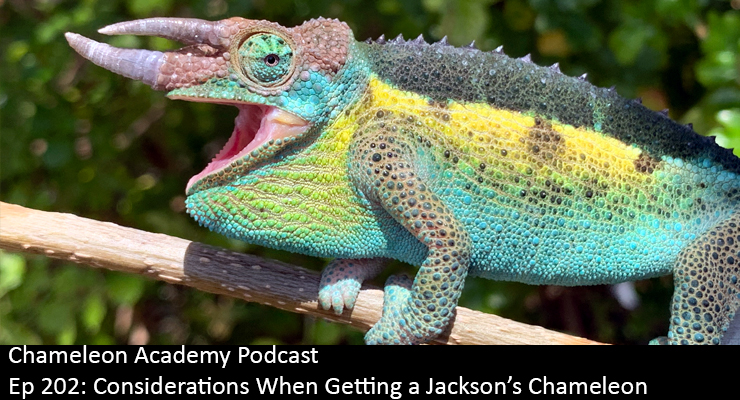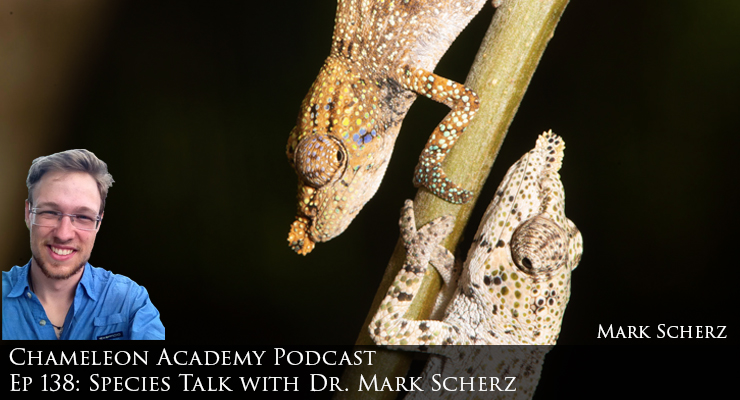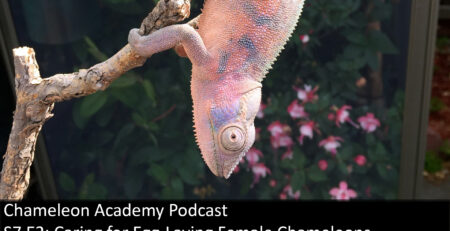Ep 202: Considerations when getting a Jackson’s Chameleon
Listen Here!
There are special considerations when buying each species of chameleon. But the Jackson’s Chameleon has more pitfalls than most. Today we will go into what to consider when buying a Jackson’s Chameleon and how to avoid making a mistake that could bring an unwelcome surprise or even heartbreak.
Link Resources
The following links will help you research Jackson’s Chameleons:
Chameleon Academy Jackson’s Chameleon Profile
Jackson’s Chameleon Community Facebook Group
Chameleon Academy YouTube Channel
A fun video about finding my Jackson’s Chameleon gave birth!
Transcript (more or less)
Introduction
If you are listening to this while you are in the planning stage of getting a chameleon you will be well prepared to buy strategically. If you are listening to this after falling in love with a Jackson’s Chameleon while out shopping for dog food then things are a little more on the fast track for you! Either way, we will start at the beginning and cover all the bases.
What Sub-Species are Available
First of all, in the market right now, circa 2021, you have ample access to two subspecies of Jackson’s Chameleon. The most common one is the largest, the Yellow-crested Jackson’s Chameleon. In the community we usually call them xanths after their scientific subspecies name xantholophus which, in latin, means yellow-crest. Nice how that works, isn’t it? The males are bright green with three horns while the females are bright green with no horns. And this is how most pet store people know Jackson’s Chameleons.
Xantholophus has an interesting background in that, in the US, we have a consistant supply of specimens that originated from Hawaii. Details are hazy, but there are rumors of now Jackson’s Chameleon populations set up on the US mainland specifically for supplying the pet trade. Details are hazy because the legality of this is questionable. But so is bringing them in from Hawaii. So there is some gray area here of which I do not have an answer. The significance to you making a decision on what chameleon to get is that the Hawaiian population is in a sort of genetic bottleneck as they all originated from a few dozen individuals imported there in the 70s and escaped. This has no bearing on their suitability as a pet, but if you have any aspirations of breeding your chameleon I highly encourage you hold out for a specimen from Kenyan bloodlines. These are harder to find as adults, but if you plug into the dedicated community, such as is on the Jacksons Chameleon Community group on Facebook, you will find that serious breeders tend to work only with the Kenyan bloodlines. Since Kenyan bloodlines are harder to find and more expensive to start with, a breeder with Kenyan bloodlines will be well aware of what they are doing and can share that with you. If the breeder is not sure whether they have Hawaiian or Kenyan then you should assume they are Hawaiian in origin.
So, enter in a second subspecies that has become more common lately called the Machakos Hills Jackson’s Chameleon. This ones’ scientific name is Trioceros jacksonii jacksonii and it has a myriad of common names. It is called the true Jacksons chameleon, the Kenyan jacksons chameleon, the rainbow Jacksons, and, at one point it was called the willigensis jacksons chameleon. This was confusing because it sounded scientific, but it was never an official scientific name. We generally don’t like to use it because it tries to sound scientific and is deceiving. The males have three horns and a bright yellow and green flank with blue cheeks while the females mess everything up and show one or three horns. This is very important because anyone who believes that you can sex jackson’s chameleons by their horns will incorrectly identify a female Machakos Hills Jackson’s Chameleon as male. This wouldn’t be such a big deal as the females are wonderful chameleons to keep. Except for the next big thing to take into account. And that is that female Jackson’s chameleons often come to you pregnant. And if they aren’t now, if they have ever been exposed to a male in their life, they usually will be later when you least expect it. Especially if you think it is a male! The universe just works that way!
So, before we even get into how to get a hold of a healthy chameleon you have to know what subspecies and sex you are even getting! And this can get tricky. The best thing to do is to go to the chameleonacademy.com website and get familiar with the photos there of males and females. Alternatively, you can go to the Jackson’s Chameleon community Facebook group where there is a team of Jackson’s keepers that can do an ID for you. As the care of the xantholophus and the Machakos Hills subspecies are essentially the same, the real importance in getting a accurate identification is for whether you have a female or not. Because that has important future significance with how much of a surprise a sudden baby-filled cage would be.
Pet Potential of Subspecies, Gender, and Age
As far as pet potential, the choice between subspecies or male/female is a personal one. The differences in the subspecies are mostly cosmetic and you can decide whether you like color or size more. Both males and females make equally good choices. The males have the prominent horns which attract many people, but I have got to say that I greatly enjoy the personality of the female xantholophus. I have found them quicker to adjust to humans. I like the female Machakos Hills Jackson’s because they have the horns and interesting patterns. They are a little smaller so a standard cage looks bigger on them.
The Special consideration of babies
Of course, there is a major consideration with females with the possibility of babies in your life. The younger you buy her the more likely she will not produce babies. If you are buying an adult you are almost guaranteed to have babies come your way. It isn’t certain. It is just a high enough probability that you should be, at least, looking for physical and behavior signs that you should start preparing for babies.
The issue of whether you are ready to take care of chameleon babies is one of the more unique considerations that buyers of Jackson’s Chameleons need to consider upfront. Though this is true of any live bearing chameleon species, it must be highlighted more for the Jackson’s Chameleon because it is the species that commonly finds itself in big chain pet stores and other retail outlets that attract people who are the least experienced with chameleons or even reptiles. Most chameleons are egg layers and a long incubation period buffers beginners from suddenly finding a mini-horde of babies in their care.
The potential of babies may make you hesitate to take a mature female chameleon home with you and this is appropriate if you are not ready for that next step in chameleon keeping. But there are people like ten year old me who think having babies is a plus for getting a female. What could be more fascinating than raising up baby chameleons? The answer, of course, is that raising up baby chameleons is exactly the incredible experience you think it is! It is also an enormous amount of work and expense if you want to do it right. So, for those who are excited about the possibility of raising baby chameleons I will say this: I absolutely encourage you to get the experience of raising baby chameleons. It will truly be an incredible memory. But…and this is a big but….you have to commit to doing it right. The information is easily obtainable on chameleonacademy.com on how to do it. And I have podcast episodes on how to do it. And I will be doing more educational outreach to make sure the information is easy to get a hold of. So the information on breeding and raising chameleon babies is out there. Review it and know what you are getting into. Unfortunately, doing it right with chameleons is more involved than most people are willing to take on for a one shot experience. And if you cut corners you will, most likely, end up with dead chameleons. And that is not the positive experience you are looking for. So, go into it with eyes wide open.
The Best Approach: Find a Breeder
The best approach to getting a Jackson’s Chameleon will surprise no one. Find a breeder and get a 4 month old juvenile. At this point you can safely get any subspecies or gender and be assured you will have a quality start. Recognize that there will be a higher price point for a captive bred specimen and price will increase with age.
The Four Month Mark
Now, you may ask, why the four to six or even more months for a Jackson’s Chameleon when a veiled can be sold at six weeks or a panther at three months? Before I jump into that I want to do a sidebar here. Age of the chameleon really isn’t a good gauge of when a chameleon is ready to go. Each bay and each brood of babies grows at a difference pace. The most accurate way of determining when a baby is ready to go to a new home is vigor and body size. The reason we give it a month rating is because that is much easier to understand. That would be when a standard brood of babies would be ready if they grew at the average pace. But, really, the judgement of the breeder as to when the baby is well started is key. If someone is selling you a baby younger than four months then they should have a decent explanation as to why that shows they made a solid judgement.
And, here is the reason,
Jackson’s Chameleons grow at a slower pace and tend to be less hardy in the typical human house environment. Obviously, they are just as rugged as any other chameleon baby expected to survive in the wild, but they are less adaptable to the conditions we have in our homes. So there is this strange phenomena where some broods of Jackson’s have this die off at around the three month mark. Not everyone experiences this, but until we have a firmer handle on what is going on, the Jackson’s community is pushing for four months to be the standard.
What could be the reasons for this die off? It is almost assuredly two reasons. Cohabitation and lack of a nighttime drop. Babies born into captivity are usually kept in groups which causes constant stress. Jackson’s do not show stress as obviously as other species so it is often missed that this is happening right under our eyes. Add that to lack of good sleep if they do not have a distinct nighttime drop and you have stress points compounding on each other. The present working hypothesis is that the cumulative effect of these stresses becomes overwhelming at about the three month mark. Obviously, this will play out differently in each situation depending on how the babies are cared for.
With so many variables it is difficult to have long term testing to put numbers to these, but you can prove some of it out yourself. If you find yourself with baby Jackson’s Chameleons you can take out a few individuals, raise them in their own cage, and keep the rest in a group setting. You will see for yourself the difference after a couple months.
But back to you and your first Jackson’s! So, how can you avoid getting a stressed baby? Once again, work with a reputable breeder. Even if that breeder does do group raising, they should be monitoring the situation every day and removing trouble makers. It is this constant monitoring and care that you won’t get with the larger retailers selling babies…or even adults.
Cautions when buying a Jackson’s Chameleon
So let’s get down to brass tacks about finding a source for Jackson’s Chameleons. This species is widespread and has found its way into pet stores, reptile expos, and online retailers. Thus, I need to give you three major cautions about dealing with sellers of Jackson’s Chameleons.
First, Beware of companies selling young babies.
With Jackson’s Chameleons there is an epidemic of babies being sold too early – especially from online companies. And there is a reason why live bearer chameleons are so susceptible to this. When the chameleons come into an import facility or are held for transport there will always be a female who gives birth at the facility. These babies are then sold as soon as possible which means too young and at a cheap price. There is nothing we humans love more than a cheap price! At least in the moment. You can easily guess the outcome. And this scenario plays itself out on a regular basis on the Jackson’s Chameleon Community Facebook group. A new member comes on wanting help with their baby chameleon that isn’t doing well. We do our best, but we watch as these new keepers learn the hard way how much a cheap baby chameleon is not a good deal. Of course, they are not to blame. How can these new keepers know the lay of the land and where the pitfalls are? The definition of being new is you don’t know the area!
So, why don’t these places hold onto these babies longer? Well, that costs money and takes space. Unfortunately, $150 – $200 USD is about the minimum you can sell a baby chameleon for and hope to at least break even. Chameleon babies don’t like to be together and the eat a lot. So a breeder needs to have ample caging and a constant supply of food. This is expensive. If you are buying a chameleon for less than $150 then either the breeder is not making money and will soon fade away (because spouses are not impressed with a business that losses money) or else they are not caring for that chameleon for any appreciable length of time.
There are a few breeders of Jackson’s Chameleons. The serious ones breed the Kenyan bloodlines of the xantholophus. And since these babies grow slower and tend to be more sensitive than veileds or panthers, Jackson’s babies are usually sold at four months old or even six months old. At this point there is a respectable bit of money invested in this baby. Not only that, but there was significant money invested in the mother while she was pregnant. See, there is much more to a healthy baby than how it is taken care of once it is born. So, if you want a good healthy baby – and , yes, you do – plug into the Jackson’s Chameleon community, find a breeder, and be willing to pay the $150-$200. It is 100% worth it.
Second, Beware of people pushing cohabitation
it is way too common for sellers to tell you you should buy a pair and that they can live together. Jackson’s Chameleons are much more subtle in their communication than, say, veileds or panthers. And so they appear to be living in peace. This is not the case and cohabitation is a stress situation which will lead to stress. I hate to say this, but I have even heard of breeders being unethical in their attempt to sell more chameleons. They would be immediately banned from any group I am in charge of, but there is nothing I can do about a reptile show. Unfortunately, this isn’t just from unethical people. It is also from people with the best of intentions that just got the wrong information. The reason why you should immediately go elsewhere is because someone that tells you Jackson’s Chameleons can live together is either trying to take advantage of you or else keeps their chameleons that way and your baby has been the result of a mother that was stressed during pregnancy. That is an unseen strike against you that you would never be able to know about. So it is best to steer clear of any entity that supports cohabitation of chameleons.
Third, Avoid group cages
It is too common for pet stores and reptile show vendors to buy a bunch of cheap chameleons and throw them into a screen cage and sell them like fish in a barrel. This is an incredibly stressful situation and shows that these chameleons got no care before being presented to you. Yes, this is why they are so cheap. And when it comes to buying chameleons anything cheap should sound loud warning bells. The reason why anything is cheap is that no care has been given to them. The amount of care given to them is the quality you will be getting. Chameleons do their best to look healthy because that is survival to them. But you will often find a quick crash once they are alone in a cage in your home and they have spent their remaining energy trying to defend against all the chameleons they were stuffed in a cage with. Everyone loves to spend less money. When you are buying animals turn off the thrill of feeling like you got a good deal. It will trick you into a bad decision and there are no end to people that will love to take your money and run.
In summary,
- Beware of cheap babies from big companies.
- Actively avoid people, even breeders, supporting cohabitation.
- Do not buy a chameleon picked out of a group cage.
Wild Caught Jackson’s
I am a strong proponent of buying a captive born babies from a reputable breeder. But I would not be doing my job if I did not acknowledge the situation where you are heart set on bringing home the chameleon that looked you in the eye while pawing at the cage door.
At this point you need a general guide for picking out wild caught chameleons. So, here are a list of tips
- Know that if you get a female that the chances are you will have babies in your future. Female Jackson’s Chameleons have been some of the coolest chameleon pets I have had so there should be no blanket advice against them because of the baby potential. They have exceptional personalities. And it was always female Jackson’s Chameleons that got comfortable enough with me that they ate garden bugs while sitting in my hand. But the reality is that the likelihood of babies needs to be a serious consideration when getting a female.
- You will need to do a fecal check for parasites. Sometimes the establishment you are purchasing the chameleon from will have a phone number for a local reptile vet.
- Go for the feisty one. So many people want the calm one. Well, in the wild, calm ones don’t survive and it is the ones actively telling you they don’t like you in their cage that have the spunk to make it. My friend, Patrick Holmes, who works with snakes gave the hilarious story of how when he is picking out the baby snake to bring home he puts his hand in the cage and the first one to bite his hand is his choice. This is because the strongest of the babies will stand up to the king kong hand in their space. Jackson’s are a calm species so we won’t get them jumping out of the trees at us, but there is enough in them to gape and threaten us. Don’t get a chameleon if you want a good holding pet.
- Remember that the seller may be totally confident that you are getting a male, but you get babies the next month. Welcome to the Machakos Hills Jackson’s Chameleon!
You should make sure that there are no wounds on the animal and no broken bones. Chameleons help with this as often a new injury will show up as a dark or sickly yellowish spot, but check that each foot has a strong grip and the tail curls with strength until the tip.
A chameleon with internal distress will sit with its eyes closed. This is often covered up by the high stress situation of being in a showroom cage with a bunch of other chameleons. So if you see a chameleon in a group cage with its eyes closed you know the situation is very bad.
We have actually been lucky with the quality of wild caught jackson’s chameleons. Whether Hawaiian or Kenyan they have not been the mess that other chameleon species have been. But this is 100% dependent on the people involved in the process and this can change at any moment. So, even if you have had a good experience or know people who have had good experiences with wild caught Jackson’s Chameleons, keep your guard up.
Conclusion
If you continue on with the plan to get a Jackson’s Chameleon the next steps are to review their care requirements and compare them to the environment in your house to make sure you are set as far as their needs. On the chameleonacademy.com website I have an extensive care section. And, in the show notes, I have a link to the Jackson’s Chameleon Community Facebook group where you can get more support.
In other news, I am having a blast with my Chameleon Academy YouTube channel. Although I have a number of educational videos planned I am just having a lot of fun making chameleon keeper vlog videos. You can come along with me as I go branch hunting, show you around my special bank of outdoor cages for pregnant livebearing female chameleon, and I even turn a Chameleon Kit cage into a very cool plant filled garden for a newborn Machakos Hills Jackson’s Chameleon. Just search for Chameleon Academy on Youtube and you should find it. And I finally have T-Shirts and mugs available. If you go to the Youtube channel just click on the menu item that says Store and you’ll see the merch.
Thank you very much for joining me here! And it is time for me to get to work on the next podcast and video!













